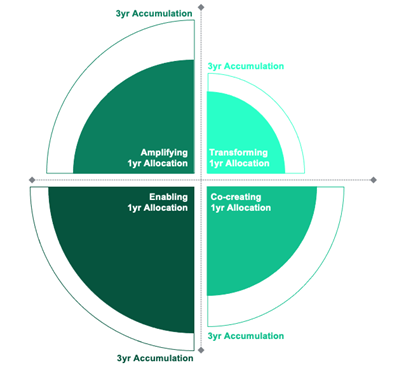In the rapidly evolving technology market, understanding the drivers of company performance is paramount when aiming to sustain and even increase your competitive positioning. Forrester’s Performance Optimization Model represents a tailored framework designed to analyze the sources of performance within IT organizations. Building on traditional accounting models that attribute performance to common factors, we extend the analysis to include factors uniquely relevant to the IT organization. These unique factors guide how IT investment accumulates, how the IT workforce grows, and how IT capabilities advance the scale and speed of business results.

In a previous blog, we outlined the four IT styles defined under a high-performance IT model. Each style helps raise performance in its own way.
Enabling. The enabling style lays the foundation for ensuring a competitive, resilient, and secure baseline operation that enables future growth. Enabling investments capture value by ensuring that core business functions are efficient and resilient, establishing the foundational capabilities necessary for day-to-day operations.
Cocreating. The cocreating style centers on developing new capabilities and redefining existing ones. Cocreating investments create value by ensuring that operations can pivot to new capabilities to sustain market relevance and competitive advantage.
Amplifying. The amplifying style focuses on maturing and advancing existing capabilities. Amplifying investments capture value by ensuring that current capabilities are strengthened and maximized with minimal interruptions to business operations.
Transforming. The transforming style moves the needle when the business model and operations require fundamental changes. Transforming investments create value by changing how things are done, transforming the business’s capability portfolio and increasing the breadth and depth of business operations.
By adopting a new investment thesis, tech leaders can set in motion forward guidance to optimize business performance. To account for various dynamic factors and help optimize efficiency, effectiveness, and productivity:
- Accumulate IT investments for the short, medium, and long term. Investments naturally flow to the areas with the highest potential return, accumulating where returns can be maximized. Over time, this begins to constrain the portfolio, forcing a greater share of the technology to concentrate on existing sources of return. As a result, the business cannot pivot to new opportunities quickly because cycles of large divestment and investment are needed.
- Grow IT labor both in depth and breadth. The workforce naturally organizes around areas with the highest priority, growing where capacity can be maximized. Over time, this growth begins to constrain the portfolio, forcing a larger share of the technology to concentrate on existing types of competencies. As a result, the business cannot absorb new competencies fluidly because cycles of high attrition and hiring are needed.
- Position productivity to maximize IT’s contribution to business results. Capabilities naturally mature in areas with the highest potential return and priority, advancing to where capacity and return can be maximized. Over time, this maturation begins to constrain the portfolio, forcing a larger percentage of technology to concentrate on existing capabilities. As a result, the business cannot adopt new capabilities at scale because cycles of high technical debt reduction and modernization are needed.
By decomposing IT performance into these fundamental factors, our framework enables a comprehensive assessment of how IT capital, IT labor, and IT capabilities contribute to current and future earnings growth applied against the unique IT styles. We employ a combination of quantitative metrics — such as efficiency, effectiveness, and productivity per IT worker — to isolate the effect that IT has on a company’s financial performance. Furthermore, our model incorporates the role of externalities, such as market and industry benchmarks, to contextualize IT performance within an even broader setting.
As the market gears up for another business cycle, IT organizations need to do the same. Those IT organizations that apply this framework can highlight how strategic planning and budgeting decisions contribute directly to business outcomes, offering actionable insights for IT leaders seeking to optimize their forward operating plans in alignment with evolving business targets. To learn more or to schedule an assessment of your organization using Forrester’s Performance Optimization Model, contact the tech insight and econometric research (TIER) team.








